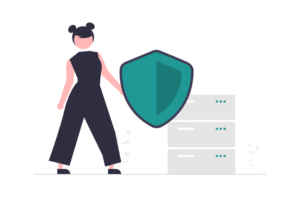Security measures for cybersecurity threats

In a world where cybersecurity threats are constantly evolving, implementing basic security measures is crucial to protect sensitive information, maintain system integrity, and ensure a safe digital environment. This article explores essential security measures, including firewalls, antivirus software, encryption, and secure passwords, providing insights into how they work and why they are important.
Firewalls
A firewall is a network security device or software application that monitors and controls incoming and outgoing network traffic based on predefined security rules. Firewalls act as a barrier between trusted internal networks and untrusted external networks, such as the Internet.
How Firewalls Work
Firewalls use a set of rules to determine whether to allow or block network traffic. These rules can be based on various criteria, including IP addresses, port numbers, protocols, and application types. Firewalls can operate in different modes, such as:
- Packet Filtering: Analyzing individual data packets to determine whether they should be allowed or blocked based on the rules.
- Stateful Inspection: Keeping track of active connections and allowing or blocking traffic based on the connection’s state.
- Application Layer Filtering: Inspecting application-level data to detect and block malicious content.
Importance of Firewalls
Firewalls are a critical component of network security, providing a first line of defense against unauthorized access and malicious attacks. They can prevent threats such as hacking attempts, denial-of-service (DoS) attacks, and malware propagation.
Types of Firewalls
- Network Firewalls: Hardware-based firewalls that protect entire networks, often used in business environments and data centers.
- Host-Based Firewalls: Software-based firewalls installed on individual computers or devices, providing protection at the endpoint level.
Antivirus Software
Antivirus software is a security program designed to detect, prevent, and remove malicious software (malware) from computers and devices. It plays a crucial role in protecting against viruses, worms, Trojans, spyware, ransomware, and other types of malware.
How Antivirus Software Works
Antivirus software uses a combination of techniques to detect and remove malware:
- Signature-Based Detection: Scanning files for known malware signatures, which are unique patterns associated with specific malware.
- Behavioral Analysis: Monitoring system behavior to detect unusual or suspicious activities that may indicate malware presence.
- Heuristic Analysis: Using algorithms to identify new or unknown malware based on patterns or characteristics.
Importance of Antivirus Software
Antivirus software provides protection against a wide range of malware threats, helping to maintain system integrity and prevent data loss. It is essential for personal computers, business environments, and mobile devices.
Key Features of Antivirus Software
- Real-Time Scanning: Continuous monitoring of files and processes to detect and block malware in real-time.
- Regular Updates: Frequent updates to ensure the software can detect the latest malware threats.
- Quarantine and Removal: Isolating and removing infected files to prevent the spread of malware.
Encryption
Encryption is a process that transforms readable data (plaintext) into an unreadable format (ciphertext) to protect it from unauthorized access. Encryption ensures data confidentiality and is widely used to secure sensitive information, both in transit and at rest.
How Encryption Works
Encryption uses mathematical algorithms and keys to convert plaintext into ciphertext. Decryption is the reverse process, using the correct key to convert ciphertext back into readable plaintext. Encryption algorithms can be symmetric or asymmetric:
- Symmetric Encryption: Uses the same key for both encryption and decryption. It is efficient but requires secure key distribution. Common symmetric algorithms include Advanced Encryption Standard (AES) and Triple Data Encryption Standard (3DES).
- Asymmetric Encryption: Uses a pair of keys, one public and one private. The public key encrypts the data, and the private key decrypts it. Asymmetric encryption is used for secure key exchange and digital signatures. Common asymmetric algorithms include RSA and Elliptic Curve Cryptography (ECC).
Importance of Encryption
Encryption is crucial for protecting sensitive information from unauthorized access and ensuring data confidentiality. It is used in various applications, such as secure communications, data storage, and online transactions.
Common Uses of Encryption
- Secure Communications: Encryption is used to secure data transmitted over the Internet, such as in HTTPS (secure HTTP), Virtual Private Networks (VPNs), and encrypted messaging.
- Data Storage: Encryption protects sensitive data stored on computers, servers, or cloud services, preventing unauthorized access in case of a security breach.
- Email and File Encryption: Encryption is used to secure email communications and file transfers, ensuring that only authorized recipients can read the content.
If you are reading this, then why not read some more relevant articles given below?
Secure Passwords
Secure passwords are a fundamental aspect of cybersecurity, providing a primary line of defense against unauthorized access to accounts, systems, and data. A secure password is strong, unique, and not easily guessable.
Characteristics of Secure Passwords
- Length and Complexity: A secure password should be at least 12 characters long and include a mix of uppercase letters, lowercase letters, numbers, and special characters.
- Unique and Unpredictable: A secure password should be unique for each account and not based on easily guessable information, such as common words or personal details.
- Avoiding Common Patterns: Avoid using common sequences (e.g., “123456”) or dictionary words that are easily guessable.
Importance of Secure Passwords
Secure passwords help prevent unauthorized access to accounts and systems, reducing the risk of data breaches and identity theft. They are a critical component of user authentication and access control.
Best Practices for Secure Passwords
- Use a Password Manager: A password manager can generate and store secure passwords, reducing the risk of password reuse or weak passwords.
- Enable Multi-Factor Authentication (MFA): MFA adds an extra layer of security by requiring a second form of authentication, such as a code sent to a mobile device.
- Regularly Change Passwords: Change passwords periodically and immediately if you suspect a security breach.
- Avoid Sharing Passwords: Do not share passwords with others, and avoid using public or unsecured networks to enter sensitive information.